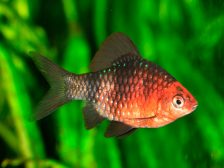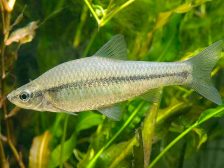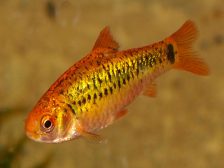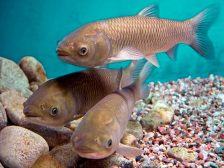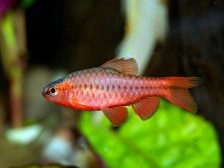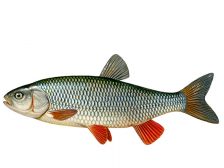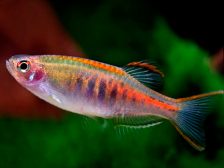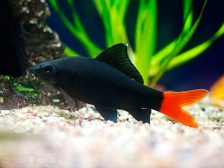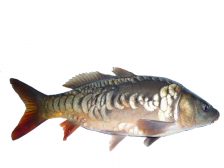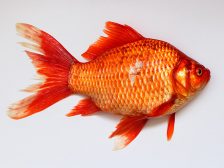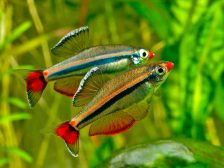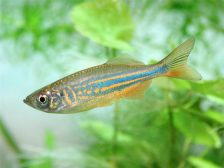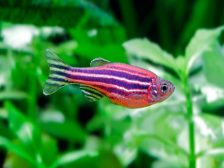Carp fish
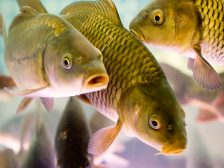 Description: Unlike its ancestors, the carp is hardy, tenacious and more prolific. The carp is yellow-green or brown, but its color may vary depending on the habitat. The head is large, the mouth is retractable. On the upper lip are two pairs of mustaches. The body of carp, which lives in a lake or in a pond, is short and thick; the body of the river carp is more slender and elongated. The sides of the carp’s body are golden and the back is dark, almost black. The little fish grows very fast and in one season (from spring to autumn) can gain up to 300-500 g of weight. For the winter, the carp goes to deep pits, its body gets covered with a thick layer of mucus, the fish stops eating and slows down its breathing.
Description: Unlike its ancestors, the carp is hardy, tenacious and more prolific. The carp is yellow-green or brown, but its color may vary depending on the habitat. The head is large, the mouth is retractable. On the upper lip are two pairs of mustaches. The body of carp, which lives in a lake or in a pond, is short and thick; the body of the river carp is more slender and elongated. The sides of the carp’s body are golden and the back is dark, almost black. The little fish grows very fast and in one season (from spring to autumn) can gain up to 300-500 g of weight. For the winter, the carp goes to deep pits, its body gets covered with a thick layer of mucus, the fish stops eating and slows down its breathing.
Species: Carp.
Family: Belongs to the family of carps.
Life Expectancy: Up to 30 years.
Body length: Usual length is 50-70cm.
Rare length: up to 1.5 m.
Weight: Up to 70 kg.
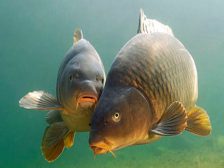 Fish spawning: The spawning of carp takes place in strict sequence: the first is the group of small fish, then middle fish, the largest carp spawns the last. The age of carp is not a sufficient condition to achieve puberty. The length of the body of the male should be at least 29 cm, the body of the female is larger and reaches 35 cm. A large female is capable of laying over a million eggs. The best period for the spawning of carp begins with sunset and lasts up to midday. After spawning the carp leaves this place immediately and behaves passively within one or two weeks.
Fish spawning: The spawning of carp takes place in strict sequence: the first is the group of small fish, then middle fish, the largest carp spawns the last. The age of carp is not a sufficient condition to achieve puberty. The length of the body of the male should be at least 29 cm, the body of the female is larger and reaches 35 cm. A large female is capable of laying over a million eggs. The best period for the spawning of carp begins with sunset and lasts up to midday. After spawning the carp leaves this place immediately and behaves passively within one or two weeks.
Nutrition: Nutrition of fish is diverse: worms, insects, small crayfish, frogs, snails, clams, young stems of reeds, fish eggs. Large carp hunts even for the little representatives of its own kind.
Fishing: For carp fishing, the best time of the year is summer. In summer the carp begins to feed actively. For catching carp in summer, lures of both animal and vegetable origin will be helpful. The most important thing is to find the location of the carp. When the water temperature is + 20 ° C, the carp moves to depth places where the temperature is much lower. At this time one should search the carp in almost all old channels, small and large valley reservoirs, and also in deep pits. In winter, they should be looked in the bottom. The vegetable bait for the carp is barley, peas, curd, corn kernels, boiled potatoes, bread.
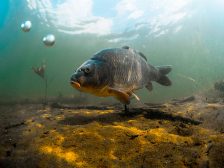 Gear: To catch carp there are many opportunities. These are float fishing rods, bottom gear and feeder rods. The thickness of the line depends on the size of the carp. For carp fishing with a weight of 1.5-2 kg, the thickness of the leash is 0.3 mm. For carp fishing weighing 10 kg a line with thickness of 0.7 mm is needed. For catching a carp a camouflage of gear and fisherman is needed. The sizes of hooks are selected according to the bait, but double-strength hooks are required. The feeder is considered to be a more reliable rod.
Gear: To catch carp there are many opportunities. These are float fishing rods, bottom gear and feeder rods. The thickness of the line depends on the size of the carp. For carp fishing with a weight of 1.5-2 kg, the thickness of the leash is 0.3 mm. For carp fishing weighing 10 kg a line with thickness of 0.7 mm is needed. For catching a carp a camouflage of gear and fisherman is needed. The sizes of hooks are selected according to the bait, but double-strength hooks are required. The feeder is considered to be a more reliable rod.
Habitat: The Araks River, The Akhuryan River, The Hrazdan River, The Arpa River, The Metsamor River (Sevjur), The Kasakh River (Armenia), The Amur River (river in East Asia), the Mekong River (river in China, Laos, Thailand, Cambodia and Vietnam, the largest river on the Indochina Peninsula), the Menam-Chao Praya River (the largest river in Thailand), the Baltic Sea, The Black Sea, the Caspian Sea, the Don River, the Ussuri River, the Sungari River (river in the north-east of China), the Danube River, the Volga River, the West Dvina River, the Neman River, the Sea of Azov, the Aral Sea, the Ob River, the Irtysh River , the Yenisei River, Lake Khanka, the Pacific Ocean, Sumatra Island, Kalimantan Island, Lake Balkhash, the Indigirka River (river in north-eastern Yakutia), the Kolyma river, the Hillock river, the Chikoy river and so on. We can say that the carp is common throughout the Earth, except for South America and Australia.
The most common species of carp fish: There are about 2000 species in the carp family. Bala shark, char, blackbrowed, stone moroko, checker barb, ticto barb, white-finned gudgeon, grass carp, silver carp, verkhovka, cherry barb, roach, caspian fish, giant barb, hankhin gudgeon, chub, bream, zebrafish, danio- zebrafish, two-coloured labeo (this kind is included in the Red book of the International Union for the conservation of nature), abbottina, Dnieper barbel, souffia, Elopichthys Bambusa, yellow-cheeked, asp, green barbus, gold barb, crucian carp, agosia, cardinal, dwarf Altai Osman, rudd, kutum, bream, tench , malabar danio, bluefish, marina (the caviar contains poisonous substance), common roach, minnow, gudgeon, common barbel, fire barb, sturgeon, bighead carp, Sumatran barb, striped barb, five-striped barb, Romanian barbel, vimba, carp, loach, white eyed, silver crucian carp, thailand labeo, taran, Terek barbel, spotty zebrafish, bleak, black amur, black barb, black bream, ide.
Nutritional value and chemical composition of carp fish in 100 g of product:
| Fat | 5,3 g |
| Protein | 16 g |
| Cholesterol | 78 g |
| Cholesterol | 54,6 mg |
| Zinc (Zn) | 2 mg |
| Copper (Cu) | 130 mkg |
| Chloro (Cl) | 55 mg |
| Potassium (K) | 265 mg |
| Chromium (Cr) | 55 mkg |
| Nickel (Ni) | 7 mkg |
| Sulfur (S) | 180 mkg |
| Magnesium (Mg) | 35 mg |
| Phosphorus (Ph) | 210 mg |
| Sodium (Na) | 55 mg |
| Iodine (I) | 50 mg |
| Ferrum (Fe) | 0,8 mg |
| Omega-3 | 0,054 g |
| Omega-6 | 0,284 g |
| Vitamines | A,B1,B2,B4,B5,B6,B9,B12,C,D, E,K,PP |
| Calorie |
Crude -111,7 kcal |
- Stone moroko
- Barbus schuberti
- Grass carp
- Cherry barb
- Chub
- Danio- zebrafish
- Two-coloured labeo
- Mirror carp
- Gold barb
- Cardinal
- Malabar danio
- Malabar danio







